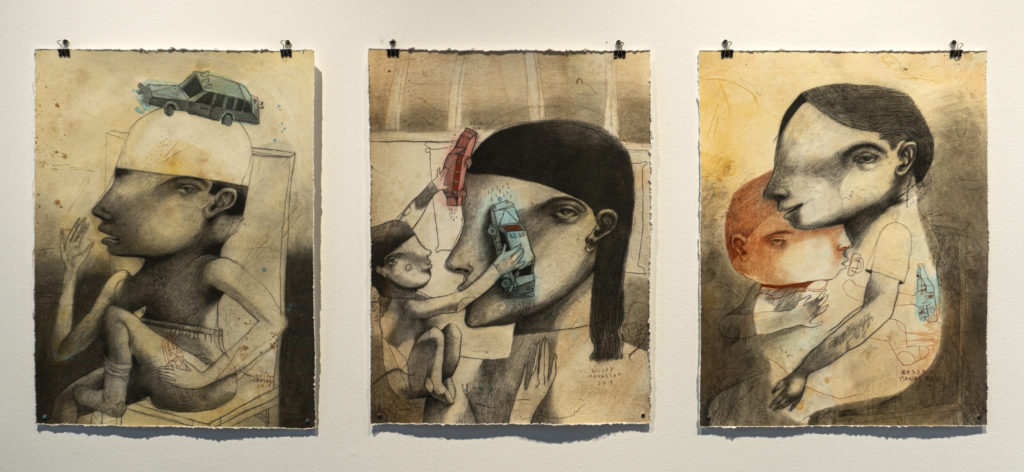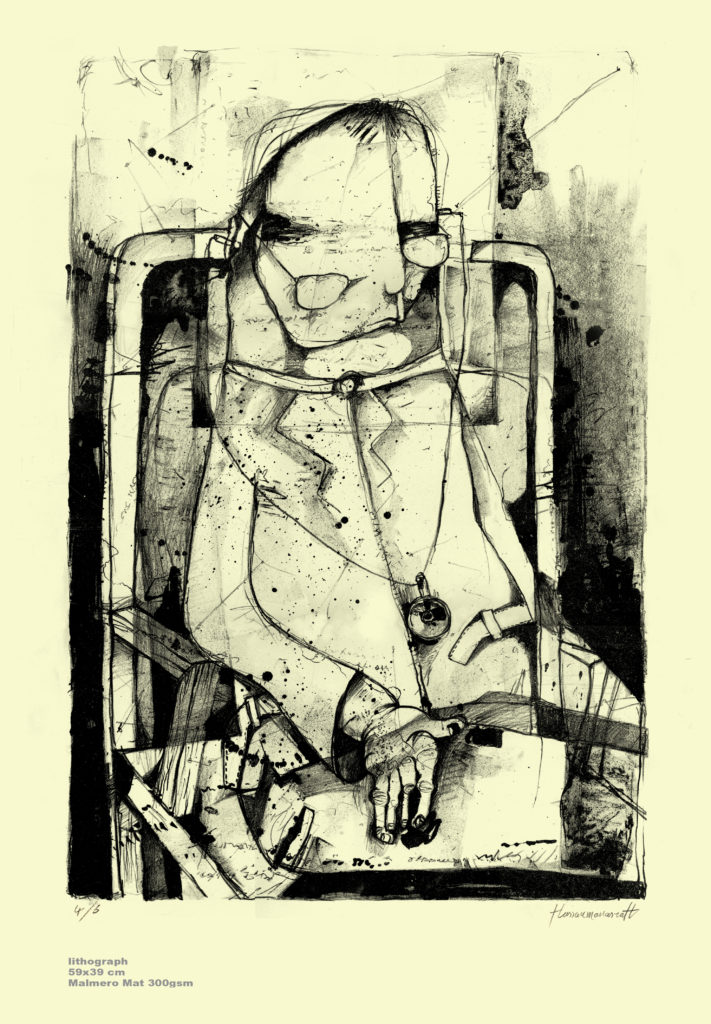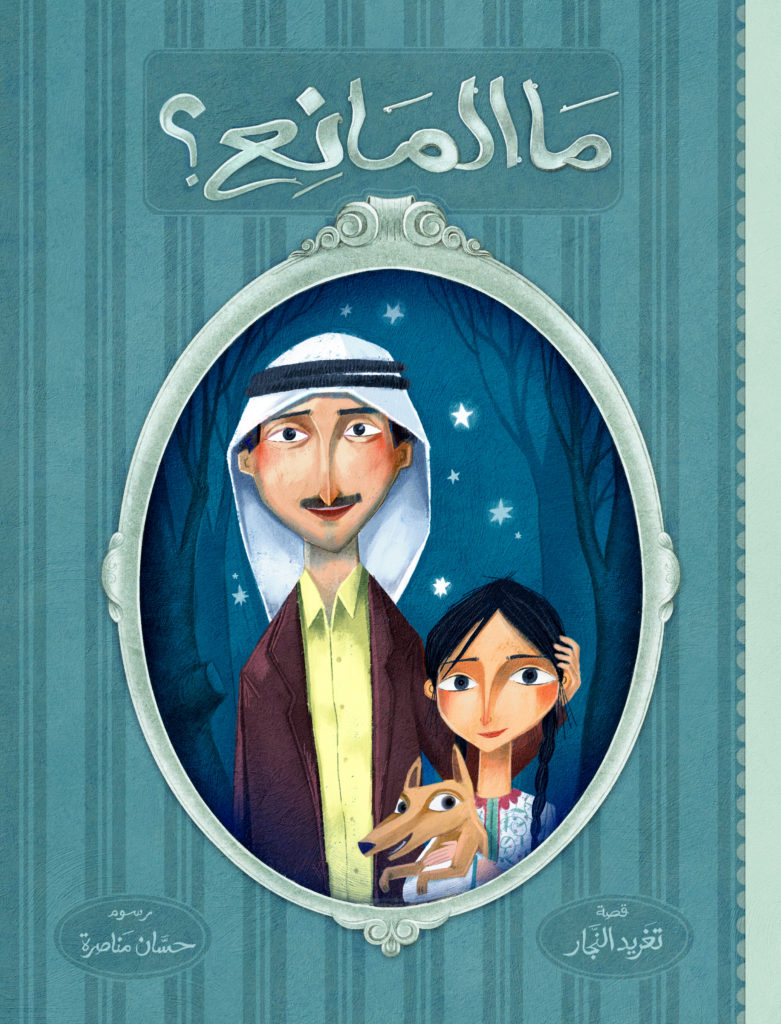Jordanian-born artist Hassan Manasrah is a man of versatile talent. Driven to consistently create, he has worked with a variety of mediums. Over the past 20 years, he has experimented with and disciplined himself to master acrylics, lithography, sculpture, animation, illustrations and more. Manasrah’s illustrations for the children’s book, The Blue Pool of Questions, won him the Etisalat Award for Arabic Children’s Literature (for illustration) in 2016, while Nostalgia, another book he also illustrated, won the Children’s Book of the Year by the same award in 2018.
In 2017, Manasrah moved to Qatar to widen his artistic horizons, and is currently an artist-in-residence at Doha Fire Station—a creative platform designed to connect artists, provide them with opportunities, and offer them exposure.
Manasrah gleans meaning and inspiration from the human experience, and has displayed his work at several exhibitions in the Middle East. His first solo exhibition at Doha Fire Station in June 2019, “Everyday Rhythm,” deftly captures glimpses of simple scenes from day-to-day life activities such as shopping or playing with a child. These commonplace scenes that Manasrah portrays attempt to express the depth and thought behind their seemingly mundane actions, which he explains: “[distinguish] us human beings from machines or pieces of furniture.”
We talk to Manasrah about what fuels him, his process to ensure he never runs out of material, the challenges he’s encountered, and how his residency has helped him thrive creatively.

Zainab Mirza: You studied interior design at university. How did you get into art?
Hassan Manasrah: To be honest, my decision to study interior design was not a conscious or deliberate choice. I have always had a desire to study the fine arts until one day the inner voice urging me to do so got louder and more urgent. So during the time I was studying interior design, I went for evening classes (drawing and sculpture) at the Institute of Fine Arts in Jordan.
Z.M.: How did you develop or hone your artistic skills? Who has influenced your art and where do you draw your inspiration?
H.M.: I consider myself an experienced person, and one that is engaged and disciplined in various artistic experiences. I use this discipline to fuel my vision to make my work successful and to seize as many opportunities as I can to push my work forward.
More broadly, my first source of inspiration is the human experience. It is the origin and the main engine in the production of my artwork. Humanity always stands at the center of the dilemma. These are the existential questions that inform my artistic style. At times, I liken my work to a mirror, which derives its presence and energy from what it reflects. I have transformed myself in recent years and developed my ability to record what is happening around me spontaneously and transform it into a form or material that captures emotions that are difficult to explain in plain language. I identify these complicated feelings on the surface of my canvas or whatever surface and medium I choose to express myself through. It’s a complicated process—a complex composition of supernatural and simple childhood experiences.
The process, while personal, is consciously planned in millions of ridiculous and important overlapping ways, and gives me the power to define my position aesthetically from lines, curves, and colors to faces, situations, and landscapes. My plan of action at the start of any project requires me to remain alert to the meaning or the moving reality of the subject at hand, and to fasten the moving and alternating nature of the subject I am portraying to the fixed reality or reflected moment of a painting, drawing, or artwork.

Z.M.: Most artists take years to develop their own style. You seem to have developed multiple ones—a casual glance at your portfolio reveals quite a few. Your work is unique and distinct, whether it’s your illustrations for children’s books, your sketches, comics or even your self-portrait. How did you cultivate them?
H.M.: I also took years to develop what I have in my portfolio—20 years of continuous work, whether through the medium of painting, engraving, printed illustrations (children's books), or comics and animation. After graduating in 2000, I retreated to my cocoon and practiced painting for almost four years as an artist. During that time I was, sad to say, unemployed, but I was able to sell a few paintings.
In 2005, I had my first experience in animation, and the first time I dealt with storyboards and directing. It was through animation that I was able to enter the world of children's books and writing.
I learned and acquired the skills needed in the printing process at the Jordanian National Museum. So by 2006, I had my first exhibition, which consisted of 25 lithographic print works and one installation made of iron.
As for my habit of daily sketching, I have dozens of sketchbooks back in my library in Amman (Jordan) and in Doha (Qatar) I have completed six sketchbooks so far. I never stopped carrying one everywhere, and I consider it a special and very intimate possession that has the unique ability to expose my talent through writing and drawing my thoughts out. From my sketchbooks, I can revisit and develop ideas for projects beyond my daily doodles.
Z.M.: Apart from your current residency, which we will get to in a moment, what galleries, events, and other platforms have you been a part of?
H.M.: During my stay in Doha, I was part of two group exhibitions with Al Markhia Gallery and a group exhibition at Al-Mutafafi. There are also future plans for setting up workshops for beginners and children's book workshops after the summer of 2019 in cooperation with the Qatar National Museum’s Department of Education Program. I expect the coming days will be busy for me, and I will do my best to work towards creating more art and accomplishing more projects in the future.
Z.M.: You’re also a resident at the Doha Fire Station. How has it been so far? How has the platform helped you professionally?
H.M.: I was very happy when I was chosen among many others to be an artist in residence in Doha Fire Station (2018-2019). I had first moved to Doha in the summer of 2017, so my residency at the Fire Station was my first real experience of the art and creative community in Doha.
Basically, what the Fire Station offers is support for the resident artists at all levels. The Station aims to provide the artists with the opportune networks and channels for the artists to develop, display, and expose their work. My residency is part of a program that consists of several provisions, which include hosting artists’ shows, hosting discussions, and forming group exhibitions. These tasks truly contributed to the development of my artistic perception and the recognition of Qatari artists, as well as artists from different Arab nationalities. Each artist has their different and unique sets of aspirations, sources of inspiration, and honed identity. You learn from observing other artists around you, an experience any artist isolated to their studio would be missing out on.
The Fire Station is also a space that is concentrated and focused on the subsistence and betterment of one’s artistic expression—free from any external distractions. Therefore the Station is a space on which I am able to further develop my skills and artistic abilities, and has allotted me the chance to introduce my art to a region that is not familiar to my work. Within the studio space I was given, I was able to complete 6 works on large canvases and more than 16 medium and small pieces that have recently been exhibited in my solo show at the Fire Station.
As for my contributions to the group exhibition at the end of our residency, I have completed an installation with the help of two technicians made of iron that stands at three and a half meters tall, at a length of two meters, and one meter in width.
I consider myself very lucky to be one of the artists who reside at the Fire Station. What it has done for my artistic career is that it has brought me back to painting and installation projects, at a time where I was more focused on creating books and comics. I truly think this is an experience that will generate more work for me in the future.

Z.M.: Judging from your diverse portfolio, you seem to have a wide range of artistic interests and experiences. One that stood out in particular was that you were Assistant Art Director for the animated series Pink Panther & Pals from 2008-2010. How did you find yourself in animation and how was the experience in comparison to other work you've done? What made you decide to move on?
H.M.: My first experience in animation was in 2005. At the time, I knew I wanted to start my career as an artist, so I thought animating was an advantageous beginning. The first place that employed me was a Jordanian animation company where I was given the opportunity to observe and soak in the work of those far more experienced than I was at the time. From there, I switched between a character designer, a background illustrator, and an animation artist where I helped produce Jordanian and Arab cartoons with the rest of the creative team. Working at that company and being surrounded by a team of experts was a valuable experience for someone at the start of their career. Eventually, the company was bought out and became MGM and the quality and expert production of our team of professionals only escalated from there. We began to produce and be a part of projects that were large in scale and production was released on a global scale. In a period of nearly 5 years, I shifted between numerous job titles and tasks, until I landed the position of assistant artistic director on the Pink Panther cartoon!
Working in such an environment has taught me how to honor a shared vision amongst a team working together towards the same endpoint—no matter how scattered across the globe the team is. From there, I started to focus on my own personal projects, like writing and drawing a comic for my newsletter and to publish my work as a comic artist in international comic festivals like: Internationale Comic-Salon Erlangen, Angoulême International Comics Festival, Cairo Comic Festival, and Festival International de la Bande Dessinée d'Alger, FIBDA. In addition, I participated in a number of art exhibitions in Switzerland, Spain, and Morocco. It was around this time that I began working on children's books.

Z.M.: How do you approach illustrating a children’s book? How involved is the author in the illustrative process?
H.M.: I wrote my first children's book in 2010 and published it through a Jordanian publishing house. With time and after completing some books, I gained the skills and expertise needed to navigate the field. I learned to draw for children at the same level of enthusiasm and spirit that I do for adults. By that I mean that I try to the best of my ability to evoke the same weight, voice, and impact through children’s illustrations as the words in text-based books do for an adult audience. I like for these illustrations to speak to a child’s perceptible reality and their imagination, and to be visually appealing to a child as a standalone art piece. For that reason, I am particular about the kinds of stories I work on and equally choosy about the writers and publishers I work with.
Z.M.: For those regional up-and-coming artists who want to do what you’re doing, was it difficult to focus your professional trajectory on your artistic career? Did you, or do you have a professional safety net? Have you found that a career in art is a lucrative one in the GCC, or are you personally still facing roadblocks—if so, what are they?
H.M.: I’m not sure if I can speak to the personal experiences of all artists. I do not know if there is anything to be said in general to rising artists. Each one of us has their own creative journey and specific circumstances to deal with. But what I can speak for is every artist’s responsibility towards their craft. In short, for every artist to move forward in their respective creative careers, they must practice their craft and to put the hours and work in. A serious artist must devote a great deal of time to get the results, a sacrifice that some may not be able to make. My experience as an artist in a GCC residency is still in its infancy, and so far it has been smooth sailing from here. All indications are that it is a good start, and I hope that in the future there will be opportunities to complete and showcase artistic projects that I can be proud of—a goal, I am sure, every artist strives to achieve.
Z.M.: What other projects are you working on?
H.M.: I’m about to complete a personal exhibition called, “Everyday Rhythm.” I have been working on a long-term project for years, a children’s book that I am deliberately taking my time with and perfecting.
I started sketching and planning for an upcoming personal exhibition. It will be based on ironwork as a reflection of the experience I gained during my current Fire Station residency. I am also trying to transfer my current gallery in the Fire Station to my native Jordan with plans to showcase in other countries as well.
Z.M.: What’s next for Hassan Manasrah?
H.M.: Creating more and more art!
A version of this article was featured in Khaleejesque’s September 2019 issue.
Words: Zainab Mirza
Images: Hassan Manasrah, Eslam Amin







